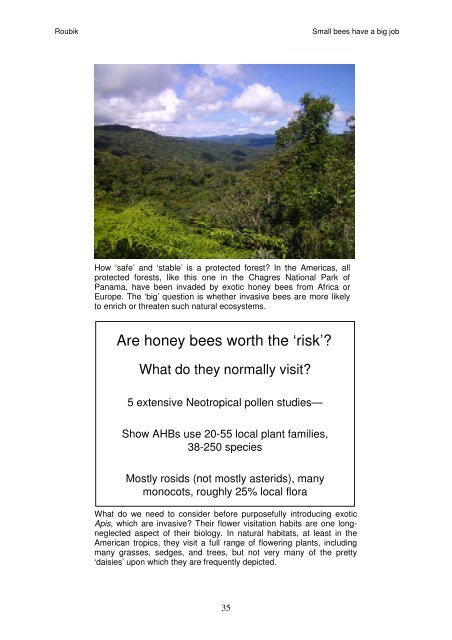- Page 1 and 2: Caring for Pollinators Safeguarding
- Page 3 and 4: Cover picture: Fruit basket with it
- Page 5 and 6: Vorwort Blütenbestäuber nehmen ei
- Page 7 and 8: L.E. NEWSTROM-LLOYD, J. COOPER, N.J
- Page 9 and 10: Ssymank, Hamm, Vischer-Leopold & Wi
- Page 11 and 12: Ssymank, Hamm, Vischer-Leopold & Wi
- Page 13 and 14: Collette International Perspektive
- Page 15 and 16: Collette International Perspektive
- Page 17 and 18: Collette International Perspektive
- Page 19 and 20: Dias The Brazilian Pollinators Init
- Page 21 and 22: Dias The Brazilian Pollinators Init
- Page 23 and 24: Dias The Brazilian Pollinators Init
- Page 25 and 26: Dias The Brazilian Pollinators Init
- Page 27 and 28: Dias The Brazilian Pollinators Init
- Page 29 and 30: Dias The Brazilian Pollinators Init
- Page 31 and 32: Dias The Brazilian Pollinators Init
- Page 33 and 34: Roubik Small bees have a big job 2.
- Page 35 and 36: Roubik Small bees have a big job A
- Page 37 and 38: Roubik Small bees have a big job De
- Page 39 and 40: Roubik Small bees have a big job As
- Page 41: Roubik Small bees have a big job Na
- Page 45 and 46: Roubik Small bees have a big job Au
- Page 47 and 48: Ssymank & Kearns Flies - Pollinator
- Page 49 and 50: Ssymank & Kearns Flies - Pollinator
- Page 51 and 52: Ssymank & Kearns Flies - Pollinator
- Page 53 and 54: Ssymank & Kearns Flies - Pollinator
- Page 55 and 56: Ssymank & Kearns Flies - Pollinator
- Page 57 and 58: Ssymank & Kearns Flies - Pollinator
- Page 59 and 60: Ssymank & Kearns Flies - Pollinator
- Page 61 and 62: Ruggiero, Adams, Saraiva North and
- Page 63 and 64: Gikungu, Hagen, Kraemer An overview
- Page 65 and 66: Gikungu, Hagen, Kraemer An overview
- Page 67 and 68: Gikungu, Hagen, Kraemer An overview
- Page 69 and 70: Gikungu, Hagen, Kraemer An overview
- Page 71 and 72: Fonseca, Saraiva, Gonçalves, de Jo
- Page 73 and 74: Fonseca, Saraiva, Gonçalves, de Jo
- Page 75 and 76: Fonseca, Saraiva, Gonçalves, de Jo
- Page 77 and 78: Fonseca, Saraiva, Gonçalves, de Jo
- Page 79 and 80: Fonseca, Alves, Saraiva, Landeiro,
- Page 81 and 82: Fonseca, Alves, Saraiva, Landeiro,
- Page 83 and 84: Fonseca, Alves, Saraiva, Landeiro,
- Page 85 and 86: Newstrom-Lloyd, Cooper, Spencer, Wi
- Page 87 and 88: Newstrom-Lloyd, Cooper, Spencer, Wi
- Page 89 and 90: Newstrom-Lloyd, Cooper, Spencer, Wi
- Page 91 and 92: Newstrom-Lloyd, Cooper, Spencer, Wi
- Page 93 and 94:
Gross, Newstrom-Lloyd, Howlett, Don
- Page 95 and 96:
Gross, Newstrom-Lloyd, Howlett, Don
- Page 97 and 98:
Gross, Newstrom-Lloyd, Howlett, Don
- Page 99 and 100:
Gross, Newstrom-Lloyd, Howlett, Don
- Page 101 and 102:
Potts, Roberts, Kunin & Biesmeijer
- Page 103 and 104:
Potts, Roberts, Kunin & Biesmeijer
- Page 105 and 106:
Potts, Roberts, Kunin & Biesmeijer
- Page 107 and 108:
Steffan-Dewenter Pollinator decline
- Page 109 and 110:
Steffan-Dewenter Pollinator decline
- Page 111 and 112:
Steffan-Dewenter Pollinator decline
- Page 113 and 114:
Steffan-Dewenter Pollinator decline
- Page 115 and 116:
Ssymank Highlights - Zusammenfassun
- Page 117 and 118:
Ssymank Highlights - Zusammenfassun
- Page 119 and 120:
Ssymank Highlights - Zusammenfassun
- Page 121 and 122:
Ssymank Highlights - Zusammenfassun
- Page 123 and 124:
Ssymank Highlights - Zusammenfassun
- Page 125 and 126:
Ssymank Highlights - Zusammenfassun
- Page 127 and 128:
Programme: 18:15 h Opening by AXEL
- Page 129 and 130:
Hamm & Ssymank Impressions of the s
- Page 131 and 132:
Hamm & Ssymank Impressions of the s
- Page 133 and 134:
Hamm & Ssymank Impressions of the s
- Page 135 and 136:
Hamm & Ssymank The pollinators buff
- Page 137 and 138:
Hamm & Ssymank The pollinators buff
- Page 139 and 140:
Hamm & Ssymank The pollinators buff
- Page 141 and 142:
Hamm & Ssymank The pollinators buff
- Page 143 and 144:
Hamm & Ssymank The pollinators buff
- Page 145 and 146:
Hamm & Ssymank The pollinators buff
- Page 147 and 148:
Hamm & Ssymank The pollinators buff
- Page 149 and 150:
Hamm & Ssymank The pollinators buff
- Page 151 and 152:
Hamm & Ssymank The pollinators buff
- Page 153 and 154:
Hamm & Ssymank The pollinators buff
- Page 155 and 156:
Hamm Fact sheet pollinators: Hymeno
- Page 157 and 158:
Hamm Fact sheet pollinators: Hymeno
- Page 159 and 160:
Hamm Fact sheet pollinators: Bees (
- Page 161 and 162:
Hamm Fact sheet pollinators: Bees (
- Page 163 and 164:
Ssymank, Kearns, Pape & Thompson Fa
- Page 165 and 166:
Ssymank, Kearns, Pape & Thompson Fa
- Page 167 and 168:
Ssymank Fact sheet pollinators: Flo
- Page 169 and 170:
Ssymank Fact sheet pollinators: Flo
- Page 171 and 172:
Hamm & Wittmann Fact sheet pollinat
- Page 173 and 174:
Hamm & Wittmann Fact sheet pollinat
- Page 175 and 176:
Hamm Fact sheet pollinators: Beetle
- Page 177 and 178:
Schuchmann Fact sheet pollinators:
- Page 179 and 180:
Schuchmann Fact sheet pollinators:
- Page 181 and 182:
Schuchmann Fact sheet pollinators:
- Page 183 and 184:
Schuchmann Fact sheet pollinators:
- Page 185 and 186:
Tschapka Fact sheet pollinators: Ba
- Page 187 and 188:
Tschapka Fact sheet pollinators: Ba
- Page 189 and 190:
Literature CANE, J., H. (2001): Hab
- Page 191 and 192:
Literature HAGEN, E. VON (1994): Hu
- Page 193 and 194:
MICHENER, C.D. (2000): The bees of
- Page 195 and 196:
Literature THERY, M., STEVENS, A.-D
- Page 197 and 198:
Links International Pollinators Ini

















